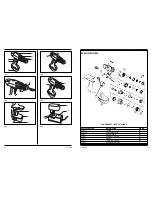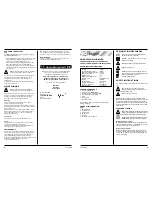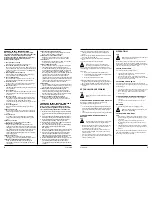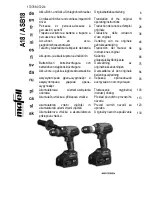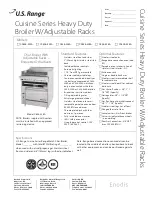
10. Before cleaning or servicing the battery or battery
charger, always remove the charger's plug from the
mains.
11. Never charge the battery if the ambient temperature is
below 10°C or above 40°C.
12. The ventilation holes of the charger should always be
free.
13. The battery may not be short-circuited.
If short-circuiting occurs, power with a high
electrical current will flow. This can lead to the
battery overheating, catching fire or exploding, which can
result in damage to the battery or the user having an accident.
Therefore:
1. Do not connect cables to the poles of the battery.
2. Ensure that there are no metal objects (nails, paperclips,
coins, etc.) in the battery holder.
3. Do not leave the battery in water or rain.
14. Damaged battery chargers or batteries which can no
longer be charged should be disposed of as special waste.
Do not dispose of them together with domestic waste.
15. Never throw the battery into water or a fire, it may
explode.
ATTACHING ACCESSORIES
Fig.B
Before changing accessorries, always remove the
battery.
TIGHTENING AND LOOSENING DRILL BITS
In addition to drill bits the machine can also hold
screwing bits with a hexagonal screw.
•
Loosen the drill chuck (4) by turning the chuck key (9).
•
Place the shaft of the drill bit in the jaw of the drill chuck.
•
Tighten the drill chuck, so that the drill bit is clamped
tight.
•
Loosen the drill chuck if you want to change the drill bit.
TIGHTENING AND LOOSENING THE
BATTERY
Fig.C
Check that the outside of the battery or the machine
is clean and dry before connecting the charger.
•
Make sure that the forward / reverse switch (6, Fig.
A) is in the middle position to avoid the machine
being switched on unexpectedly.
•
Place the battery (5) in the foot of the machine as
indicated in the diagram. Press it into place until it
clicks into place.
•
Press the locking buttons on both sides (10) before
loosening the battery and then pull the battery out of
the foot of the machine.
OPERATION
Fig.D
Always observe the safety instructions and keep to
the appropriate instructions.
Hold the machine properly and push the drill into the
work evenly. Do not force the machine. Only use drill
bits that are not worn yet. Worn drill bits have a negative
effect on the effectiveness of the machine.
SETTING THE SPEED
The machine has two drilling speeds.
•
Set the speed switch (2) to '1' for slow drilling or
tightening / loosening screws.
•
Set the speed switch to '2' for high-speed drilling.
•
Do not operate the speed switch until the motor has
come to a complete standstill.
SELECTING THE TORQUE
The machine has 16 different torque positions, with
which the power for tightening and loosening screws can
be determined.
•
Set the torque dial (3) to the desired torque position.
•
Preferably choose as low a position as possible to
move the screw. Choose a higher position if the
motor slips.
TIGHTENING AND LOOSENING SCREWS
•
Set the forward / reverse switch to 'R' to tighten
screws.
•
Set the forward / reverse switch to 'L' to loosen
screws.
DRILLING
•
Set the torque dial (3) to the drilling position.
Make sure that the forward / reverse switch (6) is
always set to 'R' for drilling.
SWITCHING ON AND OFF
Fig.A
•
Press the on / off switch (1). The revolutions of the
machine will be regulated by the time that you press
the switch.
•
If you let go of the on / off switch (1), a brake is
immediately placed on the drill chuck and it stops
running.
•
Slide the forward / reverse switch (6) to the middle
position to block the machine from being switched
back on.
Do not put down the drill until the motor has come to a
complete standstill. Do not place it on a dusty surface.
Dust can get into the mechanism.
Powercraft
5
GENERAL SAFETY INSTRUCTIONS
Warning! When using electric tools, basic safety
precautions should always be followed to reduce the
risk of fire, electric shock and personal injury,
including the following. Read all these instructions
before attempting to operate this product.
Retain for future refence.
1. Keep work area clean
Cluttered areas and benches invite injuries.
2. Consider work area environment
Don’t expose power tools to rain. Don’t use power
tools in damp or wet locations. Keep work area well
lit. Don’t use power tools in presence of flammable
liquids or gases.
3. Guard against electric shock
Prevent body contact with grounded surfaces (e.g.
pipes, radiators, ranges refrigerators).
4. Keep children away
Do not let visitors contact tool or extension cord.
All visitors should be kept away from work area.
5. Store idle tools
When not is use, tools should be stored in dry, high,
or locked-up place, out of reach of children.
6. Don’t force tool
It will do the job better and safer at the rate for which
it was intended.
7. Use right tool
Don’t force small tools or attachments to do the job
of heavy duty tool. Don’t use tools for purposes not
intended.
8. Dress properly
Do not wear loose clothing or jewelry. They can be
caught in moving parts. Rubber gloves and nonskid
footwear are recommended when working
outdoors. Wear protective hair covering to contain
long hair.
9. Use safety glasses
Also use face or dust mask if cutting operation is
dusty.
10.Don’t abuse cord
Never carry tool by cord or yank it to disconnect it
from receptacle. Keep cord from heat, oil and sharp
edges.
11.Secure work
Use clamps or a vise to hold work. It’s safer than
using your hand and it frees both hands to operate
tool.
12.Don’t overreach
Keep proper footing and balance at all times.
13.Maintain tools with care
Keep tools sharp and clean for better and safer
performance. Follow instructions for lubricating and
changing accessories. Inspect tool cords periodically
and, if damaged, have repaired by authorized service
facility. Inspect extension cords periodically and
replace if damaged. Keep handles dry, clean and free
from oil and grease.
14.Disconnect tools
When not in use, before servicing, and when
changing accessories such as blades, bits and cutters.
15.Remove adjusting keys and wrenches
Form the habit of checking to see that keys and
adjusting wrenches are removed from tool before
turning it on.
16.Avoid unintentional starting
Don’t carry plugged-in tools with finger on switch.
Be sure switch is off when plugging in.
17.Outdoor use extension cords
When tool is used outdoors, use only extension
cords intended for use outdoors and so marked.
18.Stay alert
Watch what you are doing. Use common sense. Do
not operate tool when you are tired.
19.Check damaged parts
Before further use of the tool, a guard or other part
that is damaged should be carefully checked to
determine that it will operate properly and perform
its intended function. Check for alignment of moving
parts, binding of moving parts, breakage of parts,
mounting, and any other conditions that may affect its
operation. A guard or other part that is damaged
should be properly repaired or replaced by an
authorized service center unless otherwise indicated
elsewhere in this instructions manual. Have defective
switches replaced by an authorized center. Do not
use tool if switch does not turn it on and off.
20.Warning
The use of any other accessory or attachment other
than recommended in this operation instructions or
the catalog may present a risk of personal injury.
21.Have your tool repaired by an expert
This electric appliance is in accordance with the
relevant safety rules repairing of electric apliances
may be carried out only by experts otherwise it may
cause considerable danger for the user.
22.Connect the dust extraction device
Whenever there are facilities for fitting a dust
extraction system, make sure it is connected and
used.
IMPORTANT SAFETY INSTRUCTIONS FOR
BATTERY AND BATTERY CHARGER
If you come into contact with acid from the battery,
immediately wash it off with water. If acid gets into the
eyes, rinse with plenty of water and consult a doctor!
1. Read and observe the operating instructions and safety
instructions for the battery and battery charger before
use!
2. Please note! Only use the battery and battery charger
delivered by the supplier to avoid the risk of accidents.
3. Keep the battery, battery charger and the electrical
appliance away from damp, such as rain or snow.
4. Before using the battery charger, always check that all
the cables are correctly connected.
5. Do not use the battery charger if you see that its cable is
damaged. Have the damaged cable replaced
immediately.
6. If you are not using the battery charger, remove the plug
from the mains. Do not pull out the plug by the cable.
7. If you drop the battery charger or it is interrupted by
another strong mechanical use, have it checked for
damage by a recognised professional workshop before
you use it again. Damaged parts must be repaired.
8. Handle the battery with care. Do not drop it or knock it.
9. Never try to repair the battery or battery charger
yourself. Repairs must always be carried out by a
recognised professional workshop to avoid the risk of
accidents.
4
Powercraft


